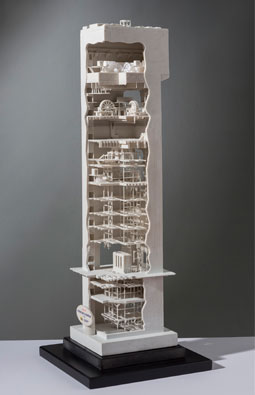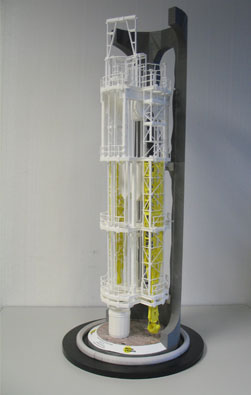Currently viewing: News Press Releases
Press Releases
-
3D Printing Adds Greater Functionality
Thursday, 1 September 2016
Known for use of best-in-class technology, Murray & Roberts Cementation has added 3D printing technology to its capability portfolio and believes that this will add greater functionality during project design stages.
Allan Widlake, business development executive at Murray & Roberts Cementation, says that use of 3D printing technology allows engineers to take designs from CAD or other modelling software and convert this into complete models. “The primary advantage is that the physical model and the virtual model are almost identical and the ergonomics of the structure can be visually checked to ensure functionality.”
It is significant that the first model produced by Murray & Roberts Cementation is of the Ivanplats’ Platreef No. 2 shaft headframe. The model is a 1:260 scale and is an accurate physical rendering of the headgear. It was printed using ceramic as opposed to plastics for aesthetic purposes, and took just 17 hours.
“3D printing of structures allows for the assessing of the constructability of the design and we believe that this could become a vital tool as it allows a far more realistic perspective. In the case of the headgear we were also able to confirm that there is sufficient space to access all components of the headgear from a maintenance and servicing perspective,” Widlake says.
3D printing, also called additive manufacturing, is the process of creating three dimensional objects from a digital model. Advances in 3D printing technology have seen it become more affordable allowing reasonably priced models to be produced, and from a planning perspective this means that engineers can use these 3D printed models to discuss with crews exactly how the construction will be done. This provides a much more tangible idea of the construction required.
Murray & Roberts Cementation was responsible for the design of Ivanplats’ mechanised, high tonnage Platreef No. 2 shaft headframe. It will be the main production shaft, capable of hoisting 6 Mtpa of ore and will also transport large mechanised equipment between surface and underground.
By comparison with most steel frame PGM headgears in South Africa, it will be a considerable concrete structure – 100.5 metres in height. The lined shaft will be 10 metres in diameter. The headframe will house all equipment necessary for operating the shaft thereby reducing the surface footprint. During sinking maximum use of permanent infrastructure was achieved in order to minimise the changeover delay from sinking to permanent conditions.
The No. 2 shaft will be sunk to a depth of 1 080 metres and will feature two high mass, high speed 40 t skips running at 18 metres per second. It will also be capable of conveying 40 tons of material or 225 persons in a single deck using a cage and counter weight arrangement.


It is significant that the first model produced by Murray & Roberts Cementation is of the Ivanplats’ Platreef No. 2 shaft headframe. Known for use of best-in-class technology, Murray & Roberts Cementation has added 3D printing technology to its capability portfolio.
